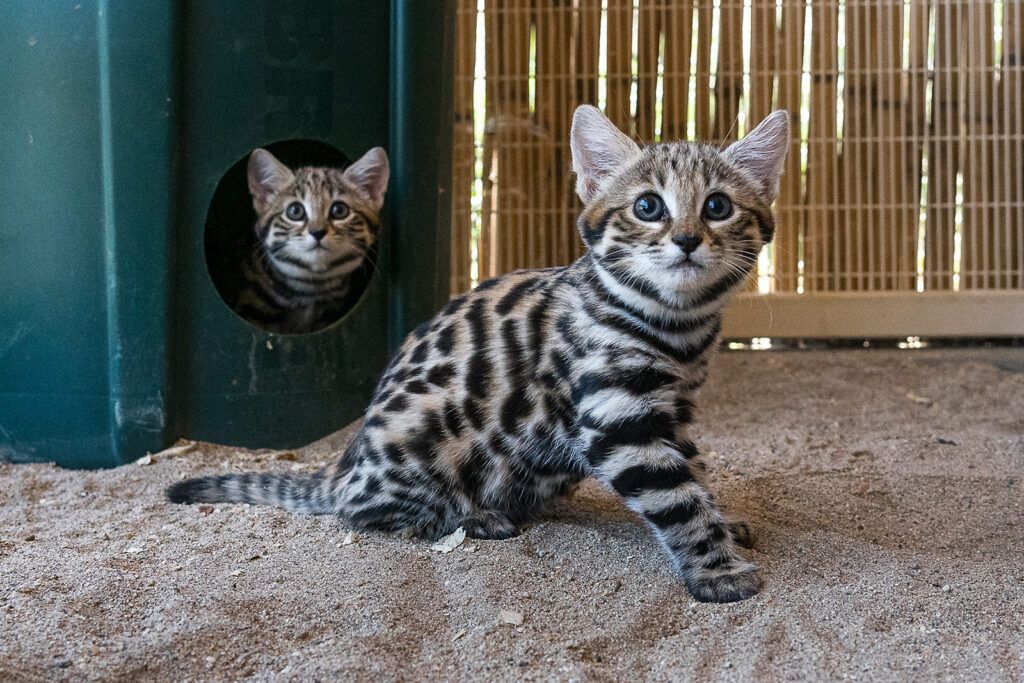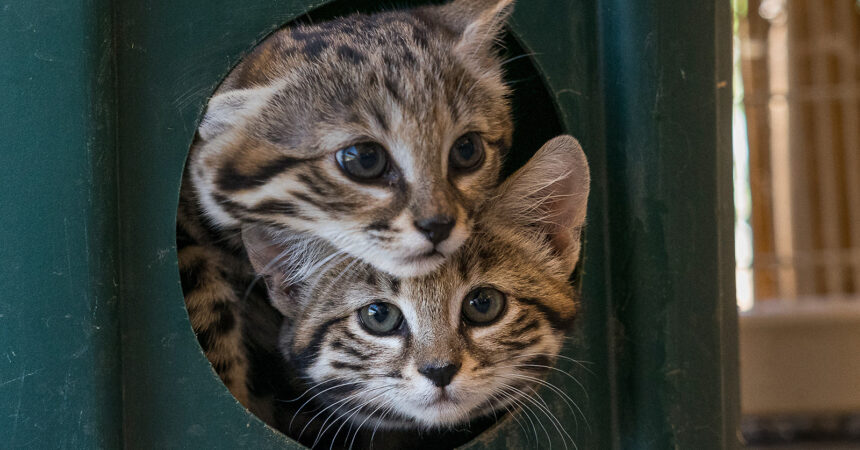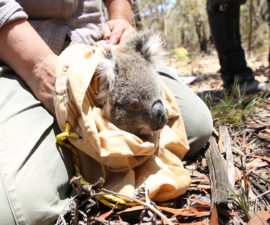Mom is Nursing a Pair of 2-month-olds
Two young black-footed cats at the San Diego Zoo Safari Park cautiously ventured out of their den to take food from one of their wildlife care specialists for their daily feeding. The kittens—male Ryder and female Skyler—were born to mother Arwen and father Sawyer on April 28, 2020.
Weighing 3 ounces at birth, the kittens now weigh about a pound and half each. They will grow to be 2 to 3 pounds and measure 14 to 20 inches in length when full-grown. They are still nursing from their mother, but the kittens have begun eating a carnivore diet.
“We are honored to care for these kittens, and the adult black-footed cats at the Safari Park,” said Chelsea Davis, wildlife care specialist, San Diego Zoo Safari Park. “San Diego Zoo Global is one of 17 organizations in the U.S. participating in the Association of Zoos and Aquariums (AZA) Species Survival Plan (SSP) for this species. The birth of these two kittens, and all births, help further our knowledge and conservation of this species.”
One of the world’s smallest cats, the black-footed cat is found in Botswana, Namibia and South Africa. Black-footed cats live in dry, open habitats, including desert, savanna and scrubland. Their name comes from the black pads and thick, black hair on the soles of their feet, which help protect them from the hot sand.
Although it is small, the black-footed cat is sometimes called “the world’s deadliest cat.” With their keen sense of hearing and smell, their predation success rate of 60 percent is the highest of any feline. In a single night, one black-footed cat can consume up to 14 rodents and birds.
This species is solitary, except for a short period of time during breeding or when a female is raising young. Due to its extremely shy and evasive nature, black-footed cats have received little attention from the conservation community. San Diego Zoo Global is part of the Black-footed Cat Working Group, bringing together multidisciplinary expertise on the species’ biology—and San Diego Zoo Global has taken a leading role in educating the cause of a disease that may threaten fragile black-footed cat populations. Motion-activated trail cameras and radio collars are used to learn more about the little felids. Biological samples collected from black-footed cats are stored in the Frozen Zoo® at the San Diego Zoo Institute for Conservation Research and provide a long-term renewable resource of genetic material, including DNA samples for studies into the conservation genetics of this species.
Black-footed cats are listed as Vulnerable on the International Union for Conservation of Nature (IUCN) Red List of Threatened Species. In 2019, only an estimated 10,000 black-footed cats remained in their native habitats. Major threats to this species include deforestation, overgrazing by livestock (leading to a reduced prey base) and indirect poisonings.

The San Diego Zoo Safari Park is home to six black-footed cats—the two kittens and four adult cats. While these kittens and their mother will remain off public view for now, two adult black-footed cats—male Sawyer and female Yuna—can be seen in their habitat at the Safari Park’s Nairobi Village.
For more details on the San Diego Zoo and the San Diego Zoo Safari Park—now open with new safety and health protocols—including yearly membership options and important information for guests planning their next visit, go to SanDiegoZoo.org/Reopen. To help maintain San Diego Zoo Global’s mission-based programs that save species around the world, visit SanDiegoZoo.org/Donate or SDZSafariPark.org/Donate.
Bringing species back from the brink of extinction is the goal of San Diego Zoo Global. As a leader in conservation, the work of San Diego Zoo Global includes on-site wildlife conservation efforts (representing both plants and animals) at the San Diego Zoo, San Diego Zoo Safari Park, and San Diego Zoo Institute for Conservation Research, as well as international field programs on six continents. The work of these entities is made accessible to over 1 billion people annually, reaching 150 countries via social media, our websites and the San Diego Zoo Kids network, in children’s hospitals in 12 countries. The work of San Diego Zoo Global is made possible with support from our incredible donors committed to saving species from the brink of extinction.





